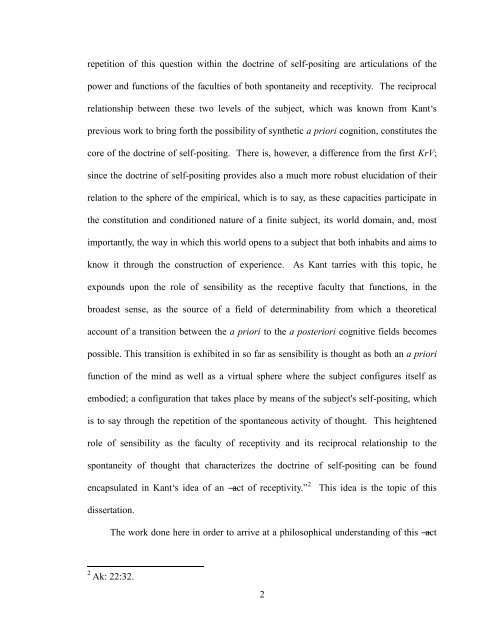The Doctrine of Self-positing and Receptivity in Kant's Late ...
The Doctrine of Self-positing and Receptivity in Kant's Late ...
The Doctrine of Self-positing and Receptivity in Kant's Late ...
Create successful ePaper yourself
Turn your PDF publications into a flip-book with our unique Google optimized e-Paper software.
epetition <strong>of</strong> this question with<strong>in</strong> the doctr<strong>in</strong>e <strong>of</strong> self-<strong>posit<strong>in</strong>g</strong> are articulations <strong>of</strong> the<br />
power <strong>and</strong> functions <strong>of</strong> the faculties <strong>of</strong> both spontaneity <strong>and</strong> receptivity. <strong>The</strong> reciprocal<br />
relationship between these two levels <strong>of</strong> the subject, which was known from Kant‘s<br />
previous work to br<strong>in</strong>g forth the possibility <strong>of</strong> synthetic a priori cognition, constitutes the<br />
core <strong>of</strong> the doctr<strong>in</strong>e <strong>of</strong> self-<strong>posit<strong>in</strong>g</strong>. <strong>The</strong>re is, however, a difference from the first KrV;<br />
s<strong>in</strong>ce the doctr<strong>in</strong>e <strong>of</strong> self-<strong>posit<strong>in</strong>g</strong> provides also a much more robust elucidation <strong>of</strong> their<br />
relation to the sphere <strong>of</strong> the empirical, which is to say, as these capacities participate <strong>in</strong><br />
the constitution <strong>and</strong> conditioned nature <strong>of</strong> a f<strong>in</strong>ite subject, its world doma<strong>in</strong>, <strong>and</strong>, most<br />
importantly, the way <strong>in</strong> which this world opens to a subject that both <strong>in</strong>habits <strong>and</strong> aims to<br />
know it through the construction <strong>of</strong> experience. As Kant tarries with this topic, he<br />
expounds upon the role <strong>of</strong> sensibility as the receptive faculty that functions, <strong>in</strong> the<br />
broadest sense, as the source <strong>of</strong> a field <strong>of</strong> determ<strong>in</strong>ability from which a theoretical<br />
account <strong>of</strong> a transition between the a priori to the a posteriori cognitive fields becomes<br />
possible. This transition is exhibited <strong>in</strong> so far as sensibility is thought as both an a priori<br />
function <strong>of</strong> the m<strong>in</strong>d as well as a virtual sphere where the subject configures itself as<br />
embodied; a configuration that takes place by means <strong>of</strong> the subject's self-<strong>posit<strong>in</strong>g</strong>, which<br />
is to say through the repetition <strong>of</strong> the spontaneous activity <strong>of</strong> thought. This heightened<br />
role <strong>of</strong> sensibility as the faculty <strong>of</strong> receptivity <strong>and</strong> its reciprocal relationship to the<br />
spontaneity <strong>of</strong> thought that characterizes the doctr<strong>in</strong>e <strong>of</strong> self-<strong>posit<strong>in</strong>g</strong> can be found<br />
encapsulated <strong>in</strong> Kant‘s idea <strong>of</strong> an ―act <strong>of</strong> receptivity.‖ 2 This idea is the topic <strong>of</strong> this<br />
dissertation.<br />
<strong>The</strong> work done here <strong>in</strong> order to arrive at a philosophical underst<strong>and</strong><strong>in</strong>g <strong>of</strong> this ―act<br />
2 Ak: 22:32.<br />
2


